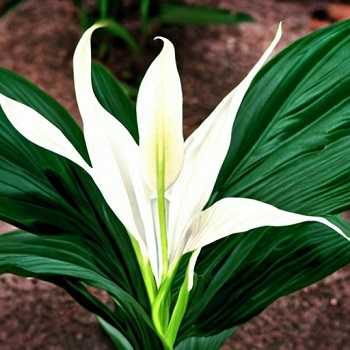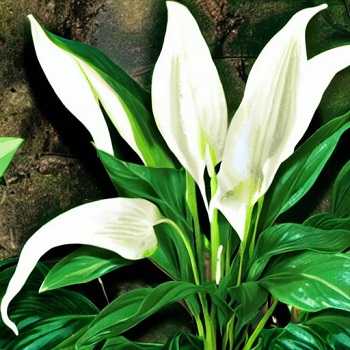As a plant lover, I have always been amazed by the beauty and ease of peace lilies (Spathiphyllum). These captivating plants, also known as spathe flowers or white sails plants, are a favorite among indoor gardeners due to their attractive leaves and elegant white flowers. One question that frequently arises among enthusiasts is, “How tall do peace lilies grow?”
Most types of peace lilies grow between 1 and 4 feet tall and wide, but some can grow as tall and wide as 6 feet. With their lovely leaves and elegant white flowers, these beautiful plants add to the beauty of indoor spaces.
Understanding the Growth of Peace Lilies
Peace lilies come from the genus Spathiphyllum and are annual grass plants. They live in the thick undergrowth of the lush jungles of Central and South America, where they thrive. In spite of the fact that they are the only ones who can see it, the lira is still a great place to start.
Average Height of Peace Lilies
Most peace lilies grow between 1 and 4 feet tall and wide, but some types can grow up to 6 feet tall and wide. Peace flowers can fit in a wide range of places because of their size, from small homes to large living rooms. The height and spread of peace lilies, however, can change depending on a number of factors, including the variety, the location, and the care given.
Variations in Peace Lily Size
Peace flowers come in different types, and each has its own unique traits. There are some types of peace lilies that have sizes that vary from the average height range listed above. Let’s study a couple of famous examples:
- Mauna Loa Supreme is a famous type that usually grows between 3 and 4 feet tall and has leaves that can be as wide as 9 inches.
- Sensation: The Sensation peace lily is a well-known species that can grow up to 6 feet tall, making it one of the tallest types.
Factors Influencing Peace Lily Size
Peace lilies grow bigger or smaller depending on how much light they get, the temperature, the humidity, and the size of the pot they are in. Let’s look more closely at each of these things to see how they affect the growth of peace flowers.

Factors Affecting the Size of Peace Lilies
1. Light Exposure
Peace flowers do best in bright light that comes from the side. Even though they can grow in places with less light, they tend to grow more slowly and may not get as big as they could. Your peace lily will get the right amount of light if you put it near a north-facing window or a few feet away from an east- or west-facing window. But it’s important to keep them out of direct sunlight, since too much of it can burn and scorch their leaves.
2. Temperature
Peace flowers enjoy temperatures between 65 and 85 degrees Fahrenheit (18 to 29 degrees Celsius). These plants don’t like extreme cold or drafts, so keep them away from windows or doors that let in cold air. Changes in weather can slow their growth and hurt their health as a whole.
3. Humidity
Peace lilies grow well in high humidity because they are from the jungle. For good growth, they need a relative humidity level of at least 50%. You can mist your peace lily’s leaves often or put it on a tray with water and rocks. This will make the air around it more wet. Putting together a group of plants can also make a microclimate with more humidity.
4. Pot Size
Choosing the right size pot for your peace lily can affect how it grows. Peace lilies like to be a little bit root-bound, which means that their roots like to be a little bit close together in the pot. So, the best container for your peace lily is one that is no more than one-third bigger than the root ball. Too much water can stay in a pot that is too big, which can cause the roots to rot and the plant to stop growing.
Blooming, Tropical Houseplant
Peace lilies are a popular choice for indoor gardening because they look good and clean the air. Here are some tips on how to care for peace lily plants and encourage blooming:
- Peace flowers do best in bright light that comes from the side. They can grow in low light, but if you want them to bloom, you should give them mild to bright light. It’s best to put them near a north or east-facing window. Don’t put them in full sunlight because it will burn the leaves.
- Temperature and humidity: Peace flowers like ranges between 65 and 85°F (18 and 29°C). They can handle temps that are a little bit cooler, but they don’t like cold air. It’s important for their health and growth that the weather and humidity stay the same.
- Watering: These plants do best in dirt that stays wet, but they can get root rot if they get too much water. They need water when the top inch of dirt feels dry. Don’t let the plant sit in water for too long because it can hurt the roots. Overwatering peace lilies is worse than not giving them enough water.
- Soil and fertilizer: Peace flowers do best in peat-based potted soil that drains well. You can also improve flow by adding perlite or sand. During the growth season (spring and summer), you should use a balanced, water-soluble fertilizer to feed the plant once a month. To stop fertilizer burn, water down the fertilizer until it is half as strong.
- Repotting: Peace lilies don’t need to be repotted very often because they don’t need a lot of food. But if the roots grow too close together and the plant starts to show signs of stress, it’s time to move it to a slightly larger pot. Use new potting soil and make sure the new pot has holes for water to drain out.
- When you prune, take off any yellow or brown leaves, which are signs that the plant is under stress. Remove dead flowers and cut back any damaged or wild leaves regularly to keep the plant looking neat. Pruning also helps plants grow new leaves and flowers.
- Peace flowers like it when there is more wetness in the air. You can make the air around the plant more wet by misting it with water or putting it on a tray of rocks and water. Don’t use leaf shine items because they can block a plant’s pores and make it harder for it to breathe.
How to Grow Peace Lilies

Here are some tips for growing peace lilies and taking care of them:
- Peace flowers like bright light that comes from the side. They can grow and bloom in less light, but putting them in a room with a lot of light will help them grow and bloom best. Don’t put them in full sunlight, because it will burn the leaves.
- How to water: Peace lilies like dirt that stays wet, but they don’t like to sit in water. When the top inch of dirt feels dry to the touch, water the plant. Make sure to water the plants well and let the extra water drain out of the pot. If you don’t want the roots to sit in water, empty the dish or tray under the pot.
- dampness: Peace flowers come from the tropics and do best in places with a lot of dampness. They can handle normal levels of humidity inside, but if the air in your home is very dry, you can increase humidity by misting the leaves with water or putting a tray of water near the plant. Putting plants close to each other can also make an environment with more moisture.
- Temperature: Peace flowers do best between 65 and 85°F (18 and 29°C). They can handle temps that are a little bit cooler, but they don’t like cold air. Don’t put them next to doors or windows that could let cold air in.
- Soil: Plant peace lilies in soil mix that holds water and drains well. A mix of peat moss, perlite, and vermiculite works well. Don’t use heavy clay soils because they can hold too much water and cause plant rot.
- Peace flowers don’t need a lot of fertilizer, but they do gain from it every now and then. Use a balanced, water-soluble fertilizer reduced to half its strength and apply it once a month during the growth season (spring and summer). Don’t give too much fertilizer, because it can burn the leaves.
- Pruning: Take off any yellow or brown leaves to keep the plant looking good and healthy in general. You can also cut back thin stems to make the plant grow larger. To make clean cuts, use scissors or pruners that are clean and sharp.
- Repotting: Peace lilies don’t usually need to be repotted very often, but they do need to be repotted if their roots grow too close together or if they outgrow their current pot. Use fresh potting soil and a pot that is one size bigger. The best time to repot a plant is in the spring, when it is growing quickly.
- Peace lilies usually bloom in the spring and summer, when their white flowers are at their best. If your peace flower isn’t growing, make sure it gets enough light and the right care. Blooming can be affected by a lack of light or bad washing.
- Common problems: In general, peace flowers are immune to pests and diseases. But too much water can cause root rot, and too little water can make the plant wilt. Check how wet the earth is and change how much you water based on that. Brown tips on the leaves could be a sign of low humidity or chemical burn from tap water. Before watering, you might want to use filtered water or let tap water sit out overnight to let the chlorine evaporate.
How large do peace lilies grow?

Most peace lilies grow between 1 and 4 feet tall and wide. But there are some types that can grow even larger, up to 6 feet tall and 6 feet wide. The final size of a peace lily relies on many things, such as the variety, the growing conditions, and how well the plant is cared for.
Indoors, peace lilies generally grow to be 2 to 4 feet tall and up to 3 feet wide. Peace lily leaves are usually big and can grow anywhere from 5 to 25 inches long, which adds to their size and presence. Because of their size, peace lilies work well as floor plants, where their bold leaves and white flowers can make a strong visual effect.
Even though most indoor-grown peace lilies are about normal size, it’s important to know that there are smaller and bigger types. Some tiny peace lily types, like “petite” peace lilies, stay small and only grow to be 10 inches tall. On the other hand, there are bigger types like the “Sensation” peace lily, which can grow up to 4 to 6 feet tall and is great for larger areas or as a statement plant.
When grown outside in the right environment, peace lilies can grow even taller. Some outdoor plants can grow up to 6 feet tall, which makes them impressive adds to yard settings. Larger peace lilies that grow outside may have leaves that are up to 6 feet long, giving them a tropical and lush look.
Peace lilies can be different sizes and grow at different rates based on how they are cared for and where they are grown. The plant’s growth and size can be affected by things like light, temperature, how much water it gets, and how much fertilizer it gets. With the right care, peace lilies can grow to their full size over the course of a few years.
Are peace lilies fast growers?
Peace lilies (Spathiphyllum) are known for their slow growth rate. They don’t grow quickly. Instead, they grow steadily, and it takes them three to five years to reach full size. This means that it might take a peace lily plant a few years to grow to its full size and get its big leaves and beautiful white flowers.
Peace lilies grow at different rates depending on many things, like how much light, heat, water, and fertilizer they get. The plant needs enough light to grow, and giving it bright, indirect light can help it grow more quickly. Peace lilies can grow more slowly if they don’t get enough light.
Temperature also affects how fast peace lilies grow. They like it between 65 and 85°F (18 and 29°C). Colder temperatures can slow growth, while warmer temperatures can speed it up.
Peace flowers need the right amount of water to grow. They like dirt that stays wet, but their roots can rot if they get too much water. Finding the right mix and letting the dirt dry out a little between waterings can help plants grow in a healthy way.
Fertilizing peace flowers can also change how fast they grow. Using a balanced fertilizer made just for flowers can give them the nutrients they need and help them grow at their best. But it’s important not to give too much fertilizer because too many nutrients can burn the leaves or cause other problems.
It’s important to know that the rate at which peace lilies grow can be different for different plants and types. Some types may grow a little bit faster or a little bit slower than others. The size of the pot and the quantity of chemicals in the dirt can also affect how the plant grows.
Growth Rate of Peace Lilies

Peace flowers (Spathiphyllum) are known for their slow growth rate. Peace lilies usually grow between one and six inches each year, depending on the type or species you choose. It will take them three to five years to grow to their full size and become adults.
There are many things that can change how fast peace lilies grow. Light is one of the most important things. Peace lilies do best with indirect sunlight, so it’s best to put them somewhere with bright, filtered light. They can live in places with less light, but it may slow their growth.
Temperature also affects how fast peace lilies grow. They like it between 18 and 29 degrees Celsius (65 and 85 degrees Fahrenheit). Temperatures that are warmer can speed up growth, while temperatures that are cooler can slow it down.
Peace flowers do best in places with an average humidity of more than 50%. Getting the right amount of humidity by misting the leaves or putting the plant on a tray with water and rocks can help the plant grow in a healthy way.
Peace flowers need the right amount of water to grow. They like dirt that stays wet, but too much water can cause the roots to rot. When the top inch of dirt feels dry to the touch, you should water the plant and make sure that any extra water runs out of the pot.
Another thing to think about is fertilization. During the growing season, peace lilies benefit from routine feedings with a balanced houseplant fertilizer. This can give them the nutrients they need to keep growing. But it’s important not to feed too much, because that can cause salt to build up and hurt the plant.
It’s important to remember that the rate at which peace lilies grow depends on the plant and its environment. Some types or mixes may grow a little bit faster or a little bit slower than others. Also, putting the plant in a new pot every year can help refresh the dirt and give it more room to grow.
How do you know if your Peace lily is happy?
Peace lilies are easy to take care but there are a few things you can look for to make sure your plant is healthy.
- The leaves of a healthy peace flower are bright green and shiny. If the leaves start to turn yellow, it could mean that the plant is getting too much or too little water. If the tips of the leaves are brown, it could mean that they are getting too much water or that the air is too dry. But it’s common for older leaves to turn brown and yellow over time.
- Wilting: If your peace lily always wilts, even though you water it regularly, it may be because it has grown too big for its present pot. Peace lilies actually do better when their roots are a little bit squished, but if the plant keeps dying even though it is getting plenty of water, it has outgrown its pot. Putting the peace lily in a slightly bigger pot can give its roots more space and stop it from dying.
- Peace lilies grow with pretty white flowers, and a healthy plant will have a lot of them. If your peace lily has stopped blooming or has a lot less flowers than usual, it may be because it doesn’t get enough light or care. Make sure your peace lily is in a place with bright, indirect light to encourage it to bloom.
- Moisture in the earth: Peace lilies like soil that stays wet, but they don’t like to sit in water. Root rot and other problems can happen if you water plants too much. On the other hand, the peace lily may die if the dirt gets too dry. Check the soil’s wetness level often by sticking your finger about an inch into it. If it feels dry at that depth, the plant needs water.
- Grow Threshold: Peace lilies that are in good health continue to grow steadily over time. If your peace lily grows slowly or doesn’t grow at all, it may be because it doesn’t get enough light or nutrients. During the growing season, you might want to use a balanced houseplant fertilizer to give your peace lily the nutrients it needs. Also, make sure the plant is in a place that gets enough filtered light.
How tall do peace lilies grow?
Most peace lilies grow between 1 and 4 feet tall and wide, making them good for both tables and floor displays. Most peace lilies that people keep as pets are about this size. But it’s important to know that there are a few types that can grow up to 6 feet tall and 6 feet wide. These bigger types are not as popular, and they may need more room to grow.
Peace lilies don’t grow too quickly or too slowly. Depending on what kind of peace lily you have, it can grow anywhere from one to six inches every year. It takes a peace lily about three to five years to reach full growth. During this time, it grows to its full size and takes on its distinctive shape, with wide, shiny leaves and beautiful white flowers.
Peace flowers need the right care and conditions to grow well. They do best in bright, indirect light, temperatures between 65 and 85 degrees Fahrenheit (18 and 29 degrees Celsius), and humidity levels above 50%. Peace lilies do best in soil that drains well, and you should water them when the top inch of earth feels dry. Don’t overwater, because it can cause root rot and other problems.
Peace lilies are flexible plants that can handle a little less light and a little bit of neglect now and then. But if you want them to grow and bloom healthily, it’s best to give them the above-mentioned ideal circumstances.
Caring for Peace Lilies to Promote Optimal Growth
Here are some important tips for taking care of peace lilies so they stay healthy and grow:
1. Watering
Peace lilies like earth that stays wet, but if they get too much water, their roots can rot. Check the top inch of dirt and water the plant well when it feels dry to the touch. Let any extra water drain away, because water that stays on the roots can cause problems. Try not to leave the plant in a saucer of water for a long time. Remember that it’s always better to slightly under-water peace flowers than to over-water them.
2. Fertilizing
Regular fertilizer gives peace lilies the nutrients they need to grow and stay healthy. Use a balanced, water-soluble fertilizer made for seedlings. Follow the directions on the box for the right way to dilute and apply the fertilizer. Fertilize your peace flowers once a month during the growing season, which is usually spring and summer. During the fall and winter, when the plants are not growing, cut back on or stop feeding.
3. Pruning
Pruning is an important part of taking care of peace lilies and can help them stay the same size and shape. Take off any yellow or brown leaves right away to help the plant grow well. You can also cut back roots that are too tall or have grown too much to help them grow bushier. To keep diseases from spreading, pruners should be clean and sharp.
4. Repotting
Peace lilies don’t usually need to be repotted very often, and they can do well even if their roots are a bit crowded. But if your plant has gotten too big for its pot and the roots are close together, it may be time to repot it. The best time to repot a plant is in late winter or early spring, when it is growing. Choose a pot that is just a little bit bigger than the one you have now, fill it with new potting soil, and make sure the new pot has holes for ventilation.
5. Propagation
If you want to make more peace lilies or bring back life to an older plant, you can divide it. When repotting, it’s a great time to divide plants. Carefully take the plant out of its pot, split the root clumps, and place each piece in its own pot. Make sure that each piece of the plant has healthy roots and a few leaves to help it grow.
In Conclusion
Peace flowers are beautiful plants that add beauty and calm to any room. They usually grow between 1 and 4 feet tall and wide, but their size can change based on things like how much light they get, the temperature, the humidity, and the size of the pot they are in. By giving your peace flowers the best conditions for growth and taking care of them the right way, you can make sure they grow well and reach their full potential. Remember that a happy peace lily is more likely to show off its beautiful leaves and elegant white flowers, making your home feel calm and welcoming.
Related Posts:
Are Peace Lilies Toxic To Cats?
Peace Lily Spiritual Meaning: Symbol, Feng Shui, Benefits (uk)
Are Peace Lilies Toxic To Dogs?
What Is the Meaning Behind White Calla Lily Flowers (Occasions To Send Them)
